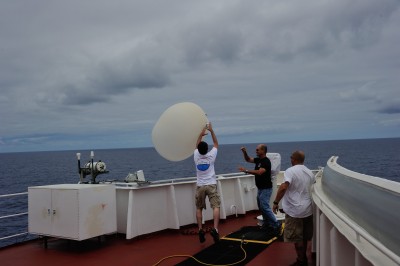A “Magical” Opportunity
Published: 2 August 2013
Editor’s note: Trevor Ferguson, graduate student, team member on the Marine ARM GPCI Investigations of Clouds (MAGIC) field campaign, sent this update on July 26, 2013.
During Leg14, I had the grand opportunity to sail along as part of the MAGIC team. Having never been out to sea, I was anxious to embark and see the ocean, clouds, and array of scientific instruments placed on the ship. One of the best and most exciting parts about the atmospheric sciences is the ability to physically see what we study in all of its grandeur, and MAGIC provided a fantastic experience for me to do so.
Since this leg was an intensive operational period, we launched eight weather balloons around the clock. Never launching a weather balloon before, I was a little apprehensive at first. I’ve heard horror stories of sondes hitting containers and diving into the water because of the turbulent nature of the relative winds near the ship deck where we launch.
Nevertheless, I learned quickly how to prepare the radiosonde, fill the weather balloon, and launch the balloon with a push to ensure success. Depending on wind speed and direction, we either launched the balloon from the basket, or near the wing of the ship’s deck. Once closer to Hawaii, the winds calmed down, allowing us to launch the balloons from the basket, which rose straight up into the air upon release.

On the way back to California, the winds flowed against us, making for some interesting launches. During these times, we launched the balloons from the ship’s wing. After releasing them, it was entertaining to watch which path the balloon would take to its ultimate fate as it danced around the railings and over the containers before its eventual ascent (or descent).
Although a lot of work around the clock to do balloon launches every three hours, it turned out to be one of my favorite parts of the experience. In addition to balloon launches, I also took psychrometer readings, measuring relative humidity. During clear skies, Ernie and I took sun photometer measurements to get aerosol optical depths using Microtops.
As a student, I spend a fair amount of time in the literature studying the thermodynamics of clouds and the interactions of electromagnetic radiation with the atmosphere. Of particular interest to me is the remote sensing of clouds and being able to infer cloud properties based upon certain measurements. Therefore, it was especially neat to see firsthand all of the instruments used during MAGIC. Equally as neat was to see the stratocumulus-to-cumulus transition of cloud regimes on our transit from California to Hawaii.
In summary, participating in this campaign has been an opportunity of a lifetime. I thank all who helped make it possible. I enjoyed working with Ernie, Mark, and Pat. They are all great mentors, making this experience a blast. I hope to have similar experiences in the future.
Trevor Ferguson
The ARM Climate Research Facility is a DOE Office of Science user facility. The ARM Facility is operated by nine DOE national laboratories, including .
Keep up with the Atmospheric Observer
Updates on ARM news, events, and opportunities delivered to your inbox
ARM User Profile
ARM welcomes users from all institutions and nations. A free ARM user account is needed to access ARM data.


















